|
 Secure Site
Secure Site
|
 |
Archive for the 'Yoga Timer' Category
 namaste lady This is the season for turning inward—darkness surpasses light, animals begin to hibernate, and the natural world quiets down in preparation for the months ahead. Your practice can benefit when you align with the changing seasons. Take a break from striving on your mat by trying a forward-bending practice. “Forward bends are, by their nature, introspective and meditative,” says Boston teacher Barbara Benagh, who designed the sequence that begins on page 66. “Forward bends are calming to the nerves, soothing, and grounding. These poses teach us that yoga is as much about surrender as effort, if not more so.”
Benagh’s practice begins with reclining hip openers to relax your back muscles and warm your hip joints. From there, her sequence moves into seated forward bends that emphasize a passive stretch of the back muscles while providing a gentle abdominal massage. Set your Zen Timer for 5 inutes. Hold each pose for up to five minutes to give your muscles time to relax and your breath a chance to deepen. Also, be sure to practice asymmetrical poses such as Ardha Ananda Balasana (Half Happy Baby Pose) and Janu Sirsasana (Head-of-the-Knee Pose) on both sides before moving on.
A willingness to surrender is your greatest ally in forward bends, helping to quiet the mind and to release the stiffness that is an obstacle to enjoying the poses. In the spirit of introspection, be more curious about the process than the destination.
adapted from Yoga Journal, by Elizabeth Winter with Barbara Benagh
Use our unique “Zen Clock” which functions as a Yoga & Meditation Timer. It features a long-resonating acoustic chime that brings your meditation or yoga session to a gradual close, preserving the environment of stillness while also acting as an effective time signal. Our Yoga Timer & Clock can be programmed to chime at the end of the meditation or yoga session or periodically throughout the session as a kind of sonic yantra. The beauty and functionality of the Zen Clock/Timer makes it a meditation tool that can actually help you “make time” for meditation in your life. Bring yourself back to balance.
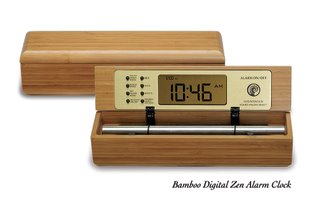 gentle wake up clock with chime, meditation timers Now & Zen – The Yoga Timer Shop
1638 Pearl Street
Boulder, CO 80302
(800) 779-6383
Posted in yoga, Yoga Timer, Yoga Timers by Now & Zen
 Meditation Calms the Mind What It Does
Quiets your mind and hones your focus so you are fully present in this workout. Because the solar plexus is associated with the third chakra, you focus on the color yellow, which is linked to this energy center of the body and believed to inspire confidence, will, and personal power.
How to Do It
Lie back in Corpse pose, palms facing up. Picture a yellow flower, its petals fully open, at your solar plexus. With eyes closed, imagine it floating up with each inhalation and down with each exhalation, riding a slow, gentle wave. Set your Meditation Timer for 5 minutes. Focus on your breath and the flower for two to five minutes.
adapted from Body + Soul
Use our unique “Zen Clock” which functions as a Yoga & Meditation Timer. It features a long-resonating acoustic chime that brings your meditation or yoga session to a gradual close, preserving the environment of stillness while also acting as an effective time signal. Our Yoga Timer & Clock can be programmed to chime at the end of the meditation or yoga session or periodically throughout the session as a kind of sonic yantra. The beauty and functionality of the Zen Clock/Timer makes it a meditation tool that can actually help you “make time” for meditation in your life. Bring yourself back to balance.
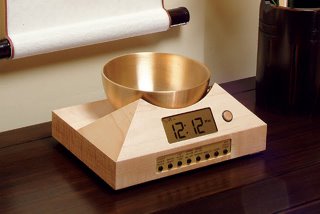 Tibetan Bowel Meditation Timers
Now & Zen – The Zen Meditation Timer and Alarm Clock Store
1638 Pearl Street
Boulder, CO 80302
(800 779-6383
Posted in intention, Meditation Timers, Meditation Tools, mindfulness practice, Well-being, yoga, Yoga Timer, Yoga Timers by Now & Zen, Zen Timers
 Whether it’s yoga to reduce muscle tension, breathing to slow the heart rate, or an herbal massage to calm a racing mind, a simple routine can be the most effective and safest road to a better night’s sleep. There is growing evidence that small behavioral changes can make a big difference in getting some good shuteye. A 2006 study published in the Journal of the American Medical Association showed that participants who made modifications like reducing stimuli in the bedroom and learning relaxation techniques improved their sleep more than those who took drugs. Whether it’s yoga to reduce muscle tension, breathing to slow the heart rate, or an herbal massage to calm a racing mind, a simple routine can be the most effective and safest road to a better night’s sleep. There is growing evidence that small behavioral changes can make a big difference in getting some good shuteye. A 2006 study published in the Journal of the American Medical Association showed that participants who made modifications like reducing stimuli in the bedroom and learning relaxation techniques improved their sleep more than those who took drugs.
adapted from Yoga Journal
To find out which rituals will work best for you, it helps to understand insomnia from an Ayurvedic perspective. Yoga’s sister science and India’s oldest known system of medicine, Ayurveda is based on the idea that the life force that exists in all of us manifests as three different energies, or doshas, known as vata, pitta, and kapha. Though everyone has some of each dosha, most people tend to have an abundance of one or two.
Vata, ruled by air and ether, governs movement in the body. Pitta, ruled by fire, governs digestion and the metabolism. And kapha, ruled by earth and water, governs your physical structure and fluid balance. Ayurveda categorizes insomnia as a vata imbalance, because vata is controlled by air—and air controls the nervous system. Calming yoga and Ayurvedic rituals reduce vata in the body.
adapted from Yoga Journal, by Kelly McGonigal
Boulder, Colorado—an innovative company has taken one of life’s most unpleasant experiences (being startled awake by your alarm clock early Monday morning), and transformed it into something to actually look forward to. “The Zen Alarm Clock,” uses soothing acoustic chimes that awaken users gently and gradually, making waking up a real pleasure. Rather than an artificial recorded sound played through a speaker, the Zen Clock features an alloy chime bar similar to a wind chime. When the clock’s alarm is triggered, its chime produces a long-resonating, beautiful acoustic tone reminiscent of a temple gong. Then, as the ring tone gradually fades away, the clock remains silent until it automatically strikes again three minutes later. The frequency of the chime strikes gradually increase over ten-minutes, eventually striking every five seconds, so they are guaranteed to wake up even the heaviest sleeper. This gentle, ten-minute “progressive awakening” leaves users feeling less groggy, and even helps with dream recall.
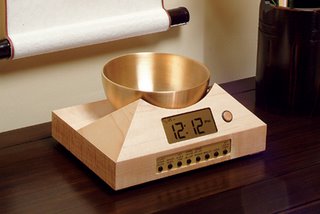 Meditation Timers and Alarm Clocks, tools for relaxation Now & Zen – The Peaceful Alarm Clock Store
1638 Pearl Street
Boulder, CO 80302
(800) 779-6383
Posted in Well-being, yoga, Yoga Timer
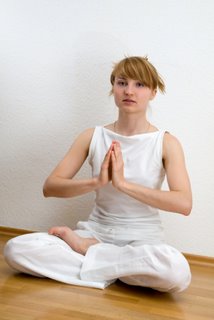 yoga Sooner or later, most of us feel a little depressed or anxious, and certainly all of us know what it’s like to feel tired. There are many different ways of treating these feelings, from exercise to meditation, from medication to a long vacation in Hawaii. But you may not realize that you have a safe, effective, and inexpensive remedy right at hand for each of these conditions. What is this magical elixir? Your own breath.
As yogis have known for centuries—and as medical science is beginning to discover—the breath has amazing recuperative powers. By controlling the breath (a practice called pranayama), the yogis found, they could alter their state of mind. The three pranayama practices described here primarily create their effects by slowing and regularizing the breath. This engages what scientists call the parasympathetic nervous system, a complex biological mechanism that calms and soothes us.
How does slower breathing help? In stressful times, we typically breathe too rapidly. This leads to a buildup of oxygen in the bloodstream and a corresponding decrease in the relative amount of carbon dioxide, which in turn upsets the ideal acid-alkaline balance—the pH level—of the blood. This condition, known as respiratory alkalosis, can result in muscle twitching, nausea, irritability, lightheadedness, confusion, and anxiety.
In contrast, slowing the breath raises the carbon dioxide level in the blood, which nudges the pH level back to a less alkaline state. As the blood’s pH changes, the parasympathetic nervous system calms us in a variety of ways, including telling the vagus nerve to secrete acetylcholine, a substance that lowers the heart rate.
Know Your Breath
Now please note that I’m not recommending that you try to breathe away chronic anxiety, fatigue, or depression. None of these conditions is easily or safely self-treated. In fact, tackling them by yourself, without professional supervision, could make them worse. But your breath can be a powerful ally in coping with temporary physical and emotional states—whether you’re despondent about an argument with a close friend, apprehensive about an upcoming job interview, or exhausted after a tough day at work.
 Use Your Chime Timer to Breathe Away Anxiety - Eisen Keisai, Woman Getting out of a Mosquito Net As with any treatment, the breathing remedy must be administered intelligently and judiciously to be fully effective. Each condition responds best to its own special breath. To calm anxiety, for example, you can purposely lengthen your exhalations; to alleviate dullness and fatigue, you can lengthen your inhalations. And to lift yourself out of an emotional pit, it’s most effective to equalize the lengths of your inhalations and exhalations.
If you want your breath to work as an extra-strength remedy, it’s a good idea to do some preliminary practice before you try to apply these techniques. First, spend some time with your breath when you’re feeling in the pink, learning to closely watch its movements and tendencies.
When you first try to look at your breath, the experience may feel akin to that of a fish attempting to describe water. Your breathing is so habitual that you’ve probably never given it much attention, and therefore you have little sense of the subtle and not-so-subtle ways it can change. But if you continue to watch, you will probably begin to notice many different dimensions, physical and emotional, to the feeling of your breath.
“The Zen Alarm Clock & Chime Timer’, uses soothing acoustic chimes that signal it’s time – gently and gradually.
Rather than an artificial recorded sound played through a speaker, the Zen Clock features an alloy chime bar similar to a wind chime. When the clock’s alarm is triggered, its chime produces a long-resonating, beautiful acoustic tone reminiscent of a temple gong.
adapted from Yoga Journal by Richard Rosen
 Bamboo Zen Meditation and Yoga Timer Now & Zen’s Chime Timer Store
1638 Pearl Street
Boulder, CO 80302
(800) 779-6383
Posted in Well-being, yoga, Yoga Timer, Yoga Timers by Now & Zen
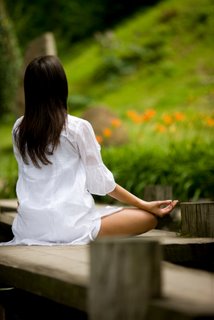 meditation New research shows that meditation can help you improve your ability to concentrate in two ways. First, it can make you better at focusing on something specific while ignoring distractions. Second, it can make you more capable of noticing what is happening around you, giving you a fuller perspective on the present moment.
Some of the most fascinating research on how meditation affects attention is being conducted by Antoine Lutz, PhD, an associate scientist at the Waisman Laboratory for Brain Imaging and Behavior at the University of Wisconsin at Madison, in collaboration with Richard Davidson and the Laboratory for Affective Neuroscience at the University of Wisconsin. Their work has shown that concentration meditation, in which the meditator focuses complete attention on one thing, such as counting the breath or gazing at an object, activates regions of the brain that are critical for controlling attention. This is true even among novice meditators who receive only brief training. Experienced meditators show even stronger activation in these regions. This you would expect, if meditation trains the brain to pay attention. But extremely experienced meditators (who have more than 44,000 hours of meditation practice) show less activation in these regions, even though their performance on attention tasks is better. The explanation for this, in Lutz’s view, is that the meditation training can eventually help reduce the effort it takes to focus your attention. “This would be consistent with traditional accounts of progress in meditation practice. Sustaining focus becomes effortless,” Lutz says. This suggests that people can immediately enhance concentration by learning a simple meditation technique, and that practice creates even more progress.
adapted from Yoga Journal by Kelly McGonigal
Although meditation can be done in almost any context, practitioners usually employ a quiet, tranquil space, a meditation cushion or bench, and some kind of timing device to time the meditation session. Ideally, the more these accoutrements can be integrated the better. Thus, it is conducive to a satisfying meditation practice to have a timer or clock that is tranquil and beautiful. Using a kitchen timer or beeper watch is less than ideal. And it was with these considerations in mind that we designed our digital Zen Alarm Clock and practice timer. This unique “Zen Clock” features a long-resonating acoustic chime that brings the meditation session to a gradual close, preserving the environment of stillness while also acting as an effective time signal.
 Zen Timer for Yoga and Meditation Now & Zen – The Zen Meditation Timer & Clock Store
1638 Pearl Street
Boulder, CO 80302
(800) 779-6383
Posted in yoga, Yoga Timer, Yoga Timers by Now & Zen
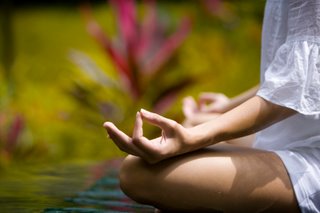 meditation Stress is the immune system’s worst enemy. Whether you’re dealing with a brief bout of craziness like Christmas shopping, or a longer-lasting stressor like divorce, your body’s ability to fight germs is compromised by physical and mental tension. Meditation can help. One study found that people who attended an eight-week mindfulness meditation class (a three-hour class once a week, plus daily meditation for an hour) ended up with stronger immune systems than those people who didn’t meditate. Researchers believe that the meditation-induced relaxation boosted the group’s immunity. Over time, high levels of stress hormones dampen the immune system, says Timothy McCall, MD, Yoga Journal’s medical editor and author of Yoga as Medicine. “So it makes sense that by practicing mindfulness-based stress reduction, your immune system benefits.” Research shows that even 10 minutes of daily meditation reduces the physical symptoms of stress. (To learn meditation techniques, go to yogajournal.com, click on “Practice,” and then choose “Meditation.”)
“The Zen Alarm Clock & Chime Timer’, uses soothing acoustic chimes that signal it’s time – gently and gradually.
Rather than an artificial recorded sound played through a speaker, the Zen Clock features an alloy chime bar similar to a wind chime. When the clock’s alarm is triggered, its chime produces a long-resonating, beautiful acoustic tone reminiscent of a temple gong.
adapted from Yoga Journal by Catherine Guthrie
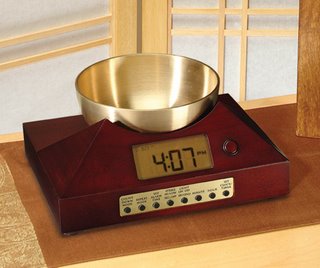 Zen Timepiece with Brass Singing Bowl, a Meditation timer to Calm your Mind Now & Zen – Zen Chime Meditation Timers and Clocks
1638 Pearl Street
Boulder, CO 80302
(800) 779-6383
Posted in Well-being, yoga, Yoga Timer, Yoga Timers by Now & Zen, zen
 how to teach yoga to kids If you’re planning to teach yoga to kids, there are a few general things to know that will enhance your experience. The greatest challenge with children is to hold their attention long enough to teach them the benefits of yoga: stillness, balance, flexibility, focus, peace, grace, connection, health, and well-being. Luckily, most children love to talk, and they love to move—both of which can happen in yoga. Children will jump at the chance to assume the role of animals, trees, flowers, warriors. Your role is to step back and allow them to bark in the dog pose, hiss in the cobra, and meow in cat stretch. They can also recite the ABCs or 123s as they are holding poses. Sound is a great release for children and adds an auditory dimension to the physical experience of yoga.
Children need to discover the world on their own. Telling them to think harder, do it better, or be a certain way because it’s good for them is not the optimal way. Instead, provide a loving, responsive, creative environment for them to uncover their own truths. As they perform the various animal and nature asanas, engage their minds to deepen their awareness. When they’re snakes (Bhujangasana), invite them to really imagine that they’re just a long spine with no arms and legs. Could you still run or climb a tree? In Tree Pose (Vrksasana), ask them to imagine being a giant oak, with roots growing out of the bottoms of their feet. Could you stay in the same position for 100 years? If you were to be chopped down, would that be OK? Would it hurt?
When they stretch like a dog, balance like a flamingo, breathe like a bunny, or stand strong and tall like a tree, they are making a connection between the macrocosm of their environment and the microcosm of their bodies. The importance of reverence for all life and the principle of interdependence becomes apparent. Children begin to understand that we are all made of the same “stuff.” We’re just in different forms.
Think of yourself as a facilitator—the term we use in the YogaKids program—rather than a teacher. Guide your children while simultaneously opening your heart and letting them guide you. They’ll no doubt invite you into a boundless world of wonder and exploration. If you choose to join them, the teaching/learning process will be continually reciprocal and provide an opportunity for everyone to create, express themselves, and grow together.
Use our unique “Zen Clock” which functions as a Yoga Timer. It features a long-resonating acoustic chime that brings your meditation or yoga session to a gradual close, preserving the environment of stillness while also acting as an effective time signal. Our Yoga Timer & Clock can be programmed to chime at the end of the meditation or yoga session or periodically throughout the session as a kind of sonic yantra. The beauty and functionality of the Zen Clock/Timer makes it a meditation tool that can actually help you “make time” for meditation in your life. Bring yourself back to balance.
adapted from Yoga Journal by Marsha Wenig
 yoga timer - tools for teaching yoga to kids Now & Zen – The Yoga Clock & Timer Store
1638 Pearl Street
Boulder, CO 80302
(800) 779-6383
Posted in intention, mindfulness practice, Walking Meditation, Well-being, yoga, Yoga Timer, Yoga Timers by Now & Zen
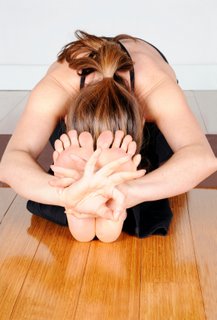 yoga forward bend Everyday stress can throw your entire system off kilter; your muscles tighten, your heart races, and your stomach starts acting up — again. A simple seated forward bend can activate a reserve of sustaining energy that, according to Chinese medicine, rests between the kidneys.
Everyday stress can throw your entire system off kilter; your muscles tighten, your heart races, and your stomach starts acting up — again. A simple seated forward bend can activate a reserve of sustaining energy that, according to Chinese medicine, rests between the kidneys. “It calms the nervous system, gets the organs fully functioning, and clears up obstructions in the kidneys and adrenal glands,” explains Daniel Max, nutrition counselor, shiatsu practitioner, and yoga instructor with Max Sense of Self in Watertown, Massachusetts. Get your qi back in no time with this quick stretch.
What It Does
Calms the mind; relieves stress; stretches the spine, shoulders, hamstrings, and back; stimulates the kidneys and adrenal glands; improves digestion; and reduces fatigue.
How to Do It
1. Sit with your legs extended straight in front of you, feet parallel with toes pointing up. Press the back of your legs into the floor.
2. Inhale deeply and lift through the upper body. With your spine straight and shoulders back, pull the navel in slightly toward the spine, creating space in the abdomen. Exhale, release, and lean forward, bending from the hip, not the waist.
3. Fold forward only as far as you can (keep your knees bent if that’s more comfortable). With each inhalation, lift and lengthen the front torso slightly; if you feel able to go further, release a little more fully into the bend on an exhale. Try not to crunch; maintain length through the spine.
4. Hold for a few breaths, allowing your body to open up. Direct your breath toward the kidneys, breathing deep into the lower back. Then inhale and sit up slowly, lifting your torso away from the thighs until your back is straight. Repeat 2 to 3 times. Set your Zen Timer for 20 minutes and continue until the chime sounds.
Use our unique “Zen Clock” which functions as a Yoga Timer. It features a long-resonating acoustic chime that brings your meditation or yoga session to a gradual close, preserving the environment of stillness while also acting as an effective time signal. Our Yoga Timer & Clock can be programmed to chime at the end of the meditation or yoga session or periodically throughout the session as a kind of sonic yantra. The beauty and functionality of the Zen Clock/Timer makes it a meditation tool that can actually help you “make time” for meditation in your life. Bring yourself back to balance.
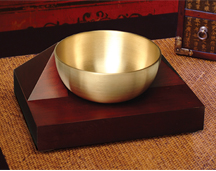 The Only Singing Bowl Yoga Timer and Alarm Clock adapted from Body + Soul Magazine, April 2008
Now & Zen’s Singing Bowl Yoga Timer Store
1638 Pearl Street
Boulder, CO 80302
(800) 779-6383
(800) 779-6383
Posted in intention, yoga, Yoga Timer, Yoga Timers by Now & Zen
 yoga can help you relax and sleep Put away your pills and roll out your yoga mat. These yoga poses help relieve insomnia.
When was the last time you had a good night’s rest? According to the National Sleep Foundation, sleep deprivation is on the rise: As many as 71 percent of Americans get far less than the recommended eight hours.
There are two primary categories of sleeplessness, says Judith Hanson Lasater, Ph.D., P.T., author of Relax and Renew: Restful Yoga for Stressful Times. One is physiological (too much coffee or alcohol, hormonal changes, illness, jet lag); the other is psychological (stress, worry, unresolved conflict).
“You may hold your thoughts at bay all day long,” explains Lasater, “but when you sleep, they’re still spinning in your mind.”Yoga helps slow the spin, she says, adding, “It’s not that you go to sleep and then relax—it’s that you get relaxed and then go to sleep.”
Poses that support you completely with props are the key to creating a relaxed body and mind. “When you feel supported, the only response is relaxation,” Lasater notes. This sleep-enhancing set includes Side-Lying Corpse Pose, which teaches “total release, total softening,” she says: “It’s the ultimate form of letting go.The focus is directed inward to shift you from doing to being.”
Do these 3 poses one after the other. If you wake up sleepless in the middle of the night, leave your bed and do any of the 3 you choose.
Supported Reclining Pose
- Place a pillow on your mat,along with a folded blanket to support your head. Roll 3 additional blankets.
- Sit in front of the pillow with your tailbone at its edge. Bend your knees and place a blanket roll underneath.
- Lean back and rest your torso on the pillow and your head on the folded blanket. Let your heels rest on the mat. Place each forearm on a rolled-up blanket, both palms turned up.
- Take several long,deep breaths. As you exhale,allow your belly to drop into your pelvis. Feel the tension melt away. Stay here for at least 15 minutes.
Simple Supported Backbend
- Stack 2 blankets, one folded around the other,and place them horizontally on the mat.
- Sit on the mat with your back to the blankets, your knees bent, and your feet flat. Lean back and place your elbows on the blankets for support and balance.
- Slowly roll backward until your lower back is completely supported by the blankets and your head is on the mat. Bring your arms out to your sides, palms turned up. Close your eyes.
- Breathe slowly and evenly, allowing your body to soften. Stay here for 1 minute, then gradually increase your time in the pose.
Side-Lying Corpse Pose (Caution: If you are more than 3 months pregnant, lie on your left side only.)
- Sit on your mat with your props—2 folded blankets and 2 king-sized pillows—nearby. Lean on one arm, then lower yourself to the mat so you’re lying on your side with your knees bent.
- Place one blanket under your head and the other between your knees, shins, and ankles.
- Place one pillow lengthwise in front of you and the other behind you so you’re lying between them; hug the front pillow as you relax into both. Close your eyes and take several slow, easy breaths. Relax your jaw and eyes. Stay here for 20 minutes.
Use our unique “Zen Clock” which functions as a Yoga Timer. It features a long-resonating acoustic chime that brings your meditation or yoga session to a gradual close, preserving the environment of stillness while also acting as an effective time signal. Our Yoga Timer & Clock can be programmed to chime at the end of the meditation or yoga session or periodically throughout the session as a kind of sonic yantra. The beauty and functionality of the Zen Clock/Timer makes it a meditation tool that can actually help you “make time” for meditation in your life. Bring yourself back to balance.
 Chime Yoga Timers and Alarm Clock
adapted from Natural Health Magazine, by Nora Isaacs
 Natural Wake Up Clock with Chime Now & Zen – The Yoga Timer Store
1638 Pearl Street
Boulder, CO 80302
(800) 779-6383
Posted in sleep, Sleep Habits, Well-being, yoga, Yoga Timer, Yoga Timers by Now & Zen
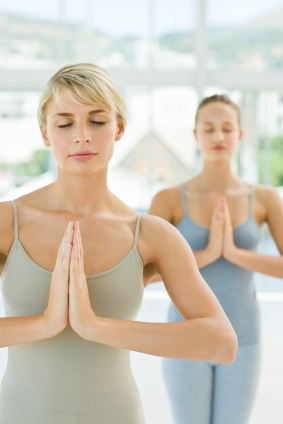 yoga to recharge Flick on your energy switch and get centered with this ancient 10-minute yoga routine.
In the high peaks of the Himalayas, there are spiritual seekers known to have extraordinary endurance and youthfulness, not to mention that ever-elusive inner peace. Their secret? A centuries-old series of daily yogalike postures known as the Five Tibetan Rites of Rejuvenation. “The monks found this routine to be a key to their age-defying vitality and inner fulfillment,” says Carolinda Witt, a teacher of the rites and author of The 10-Minute Rejuvenation Plan (Three Rivers Press, 2005). Thanks to Witt, who has adapted the rites for those who can’t travel to the Himalayas, you can experience the power of these five exercises in your own home. The moves target the chakras—the spinning energy centers that extend from the base of your spine to the crown of your head—and get them to spin rapidly, and in unison. “The rites rev up your chakras to their fullest potential,” says Witt. “It’s like turning on an inner power switch.” Besides a boost in energy, flexibility, and core strength, Witt’s students report handling stress better, feeling more focused, having a stronger sense of purpose, and experiencing an overall feeling of connectedness.
THE FIRST RITE
SpinningIncreases energy flow; improves balance and coordination; enhances circulation.
EMOTIONAL BENEFITS: Creates a sense of joyfulness and freedom.
A. Stand with your feet hip-width apart and your arms straight out to your sides at shoulder height, palms facing down. Relax your shoulders and gaze forward. Begin spinning in place, clockwise.
PHYSICAL BENEFITS:
B. Pivot on your right heel (but keep your right foot pressed into the floor—you’ll be sliding your toes in a clockwise circle) and step your left foot next to your right foot. Move at a speed that’s comfortable, and breathe normally through your nose. Avoid taking short, choppy steps with your left foot-the goal is to spin as smoothly as possible. Keep count of every turn by softly focusing on a stationary object, like a door or piece of furniture, and noting each time you pass it.
TO FINISH: When you’ve completed all your repetitions (for your first week, do three), stop and place your hands on your hips for balance. Close your eyes and take three deep, cleansing breaths.
TO PROGRESS: Turn on both feet instead of anchoring yourself with your right foot, and increase your speed.
THE SECOND RITE
Modified Leg Raise Strengthens the core, hips, lower back, legs, and neck.
EMOTIONAL BENEFITS: Promotes mental clarity and inner confidence.
PHYSICAL BENEFITS:
A. Lie on your back on a yoga mat with a folded towel under your lower back. Keep your legs together and straight and place your hands behind your head, fingers interlaced. Contract your abdominals and press your pelvis toward the mat; keep your abs tight throughout this exercise. Inhale and lift your head and shoulders off the floor slightly. Hold your breath as you bend your right knee and bring it directly over your right hip, keeping your lower leg parallel to the floor.
B. Straighten your right leg and flex your foot, pointing it toward the ceiling.
TO FINISH: Exhale and bend your right knee until your lower leg is again parallel to the floor. Then bring your right foot to the mat and slide it down to meet your left foot as you lower your head and shoulders to the mat. Repeat the move with your left leg. When you’ve completed all your repetitions (for the first week, do three), take three deep, cleansing breaths.
TO PROGRESS: Instead of raising one leg at a time, raise both legs. And instead of bending at the knee, use your abs to lift your legs straight off the mat and bring your feet toward the ceiling, keeping your lower back in contact with the mat.
THE THIRD RITE
Kneeling Backbend
PHYSICAL BENEFITS: Opens the front of the body; relieves muscle tension; stretches the spine.
EMOTIONAL BENEFITS: Helps connect you to your emotions; gives you full access to your creativity; allows you to go with the flow.
A. Kneel on a yoga mat with your legs hip-width apart, your knees in line with your hips (contract your abdominals to keep your hips from pushing forward), your toes curled under, and your hands on your buttocks, fingers pointing down. Keep your back straight.
B. Keeping your abdominals contracted, inhale as you lift your chest (without puffing out your ribs). Arch your back slightly and look up, gently squeezing your shoulder blades together, keeping your neck long. (Rather than bending back, focus on lengthening up and opening your chest.)
TO FINISH: Exhale and return to start position. When you’ve completed all your repetitions (if this is your first week, do three), take three deep, cleansing breaths.
TO PROGRESS: Deepen the stretch in your back: Press your shoulder blades together more firmly while lengthening your spine up. Squeeze your buttocks to keep your hips aligned over your knees.
THE FOURTH RITE
Tabletop Builds strong arms, wrists, shoulders, and legs; improves balance and stability; invigorates the circulatory and lymphatic systems.
EMOTIONAL BENEFITS: Initiates feelings of stability, balance, and order; enhances self–discipline and improves productivity.
PHYSICAL BENEFITS:
A. Sit on a yoga mat with your legs about hip-width apart, your knees slightly bent, and your feet flat on the floor about two feet away from you. Place your hands behind you near your hips, palms flat on the mat and fingers pointing toward your toes. Pull your abdominals toward your spine.
B. Inhale as you press down through your hands and feet, and lift your hips off the floor until they’re at the same height as your knees. Slide your knees forward until they’re aligned over your ankles. Bring your head back slightly and gaze toward the ceiling, keeping your neck long. Your posture should look like a flat tabletop with your torso parallel to the floor, arms straight, wrists aligned with shoulders, and knees aligned with ankles.
TO FINISH: Exhale and lower to the starting position. When you’ve completed all your repetitions (if this is your first week, do three), take three deep, cleansing breaths.
TO PROGRESS: Start by sitting with your legs extended in front of you rather than bent; this will further strengthen and stretch the arms, wrists, and shoulders.
THE FIFTH RITE
Pendulum Relieves fatigue and stress; improves flexibility and overall strength.
EMOTIONAL BENEFITS: Promotes insight, passion, and expansion.
PHYSICAL BENEFITS:
A. Come onto your hands and knees on the yoga mat, with your hands under your shoulders (fingers pointing forward) and your knees under your hips. Keep your arms straight and move your hands forward three to five inches. Contract your abdominals and tuck your pelvis toward your spine. Curl your toes under. Inhale and lift your knees off the mat. Lift your tailbone toward the ceiling and straighten your legs as much as possible without locking your knees until your body forms an inverted V. Press your heels toward the floor. Keep your neck in line with your back and your head between your upper arms. Gaze toward the mat.
B. Exhale, contract your buttocks, come onto the balls of your feet, and lower your hips toward the mat while shifting your weight to your hands, keeping your arms straight. Slide your head forward and up, open your chest, and gaze up slightly. Press your shoulders back; your body should be parallel to but not touching the floor.
TO FINISH: Return to start position. When you’ve done all your repetitions (if this is your first week, do three), take three deep, cleansing breaths.
TO PROGRESS: Contract your abdominals throughout the entire move to further strengthen your core.
Use our unique “Zen Clock” which functions as a Yoga & MeditationTimer. It features a long-resonating acoustic chime that brings your meditation or yoga session to a gradual close, preserving the environment of stillness while also acting as an effective time signal. Our Yoga Timer & Clock can be programmed to chime at the end of the meditation or yoga session or periodically throughout the session as a kind of sonic yantra. The beauty and functionality of the Zen Clock/Timer makes it a meditation tool that can actually help you “make time” for meditation in your life. Bring yourself back to balance.
adapted from Natural Health Magazine, by Holy St. Lifer
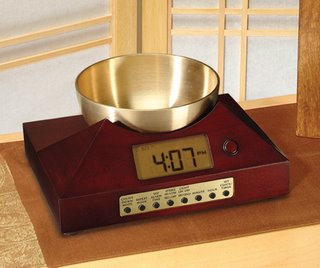 Tibetan Bowl Clock with brass bowl/gong , a perfect yoga timer with gentle gong Now & Zen – The Yoga and Meditation Timer Store
1638 Pearl Street
Boulder, CO 80302
(800) 779-6383
Posted in intention, Well-being, yoga, Yoga Timer, Yoga Timers by Now & Zen
« Previous Page — « Previous Entries
Next Entries » — Next Page »
|
|
|
|